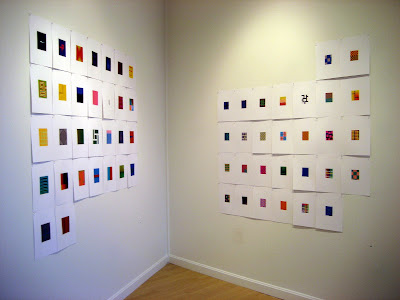
Stack, 2005-2008, encaustic on panels (quadtych), 48 x 67 inches
.
GUARANTEED BIASED, MYOPIC, INCOMPLETE, AND JOURNALISTICALLY SUSPECT

Stack, 2005-2008, encaustic on panels (quadtych), 48 x 67 inches
.

+


From the Entry: Ten paintings from my Uttar series, specifically those selected for their swatch-like combinations, each 12 x 12 inches, encaustic on panel. This is intuited color, its calculations springing from retinal response rather than theoretical planning
.

Jane Lincoln, four woodblock prints: Lincoln's grids explore hue, value, temperature and chroma. Each print is based on one selected color and then expanded in 36 one-inch squares. Within each print there is a pair of identical color squares. The two are positioned side by side, horizontally or vertically. The placement of the pair varies so as to invite the viewer to closely examine the differences between colors. Color interaction can make the pair surprisingly challenging to identify.
The white-line print was developed in nearby Provincetown in the early 1900s. Jane describes it on her website.
.

Nancy Simonds, gouache-on-paper paintings: Their Scully-esque blocks are juicy, bursting with beauty and visual energy as the hues rub up against one another as well as nestle into a colored field. The paint surface, which you can't see well from the image above, is sponged off selectively to reveal a visual texture that varies in density and intensity
At the end of the long, narrow gallery is a smaller exhibition space where the work of Chris Ashley and Rose Olson is installed. We'll enter there in a moment. Continuing clockwise around the main gallery are alcoves that contain the work of Susanne Ulrich, Nancy White and Mel Prest. We'll get to those, too.
From left, above: Nancy Simonds, Rose Olson, Suzanne Ulrich

Above, a peek into the smaller back gallery and Chris Ashley's digital prints. Chris creates images on the computer using HTML code, one a day. Each image is built up line by line--"not the result of software tricks," he says. The image is meant to be viewed on a monitor as pixels of light, but digital printing renders a crisp and luminous image which, in relation to the one on the screen, becomes an actual object. The installation reflects the calendar grid of the month in which the work was made
Below, the full installation


Rose Olson shares the same gallery room with Chris Ashley. Rose paints veils of color on a maple or birch ply surface using interference pigments, so the painting changes both as the light changes or as you move in relation to the painting. The wood grain, barely visible beneath the surface, challenges the strict horizontality of the image, yet the mood of the work is dialog--perhaps even contemplation--not confrontation.

Back in the main gallery, continuing clockwise around, we come to an alcove containing the collages of Suzanne Ulrich. Made of torn, cut and pasted papers, the work is both rational and romantic
Continuing clockwise in the next alcove is the sculpture of Nancy White. Nancy calls her small painted aluminum constructions "a personal conversation with the viewer," but there is also the conversation between the object and its shadow, which is an integral, and mutable, element of the work. The sculptures were difficult to photographs, so I have included an image from her website, below


Coming back around, the work of Mel Prest is contained both within an alcove and on the wall facing you as you enter the gallery. Working with a spectrum of achromatic hues, Mel uses small-scale elements in repeated geometric formation to focus your attention on the richness of the grays. The edges of the work are painted with fine parallel lines, so there's an optical energy that powers the work. A combination of natural light on one side and incandescent on the other creates a sense of disorientation--all the better to challenge your viewing
If you find yourself on Cape Cod, the exhibition is up through October 2. Be sure to pick up the small catalog, which is a gorgeous little color object on its own.
.



More contrasts, above
Below, warm and cool hues with their chromatic variations

.
FYI, below are a couple of page spreads from the updated editon of the commercially printed volume. If I can't have the big book, I can at least have the small version of The Interaction of Color. I’ve just ordered one for myself.



Amazon offered these pages for viewing. See the one above? There's a similar silkscreen page, off to the background, in the second image from the top of this post
Below it's the Illusion of Transparency

Next post: Calculated Color
Related posts: Homage to the Square and Geometric at MoMA, Part 4 with images of Albers' silkscreen squares
.



Bill Armstrong, Mandala 452, 2003, C-print. Image from the ClampArt website
.________________________
.
Gilbert Hsiao, a painter of retinally invigorating canvases, many of them geometrically shaped, is one of a number of artists participating in the American Abstract Artists show at The Painting Center in SoHo this month, and at the big Minus Space show at PS1 that opens next month.









